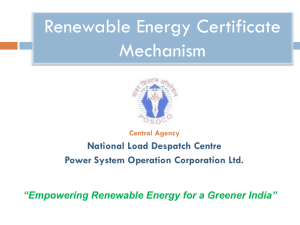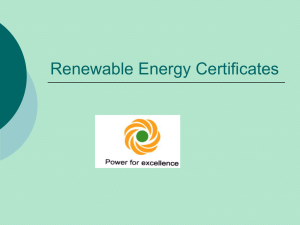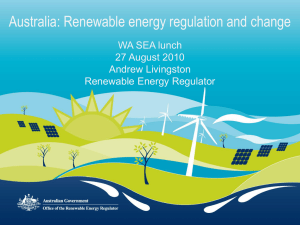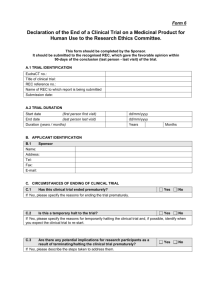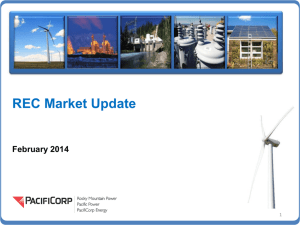to read about the CNMEC Renewable Energy Credits Program
advertisement
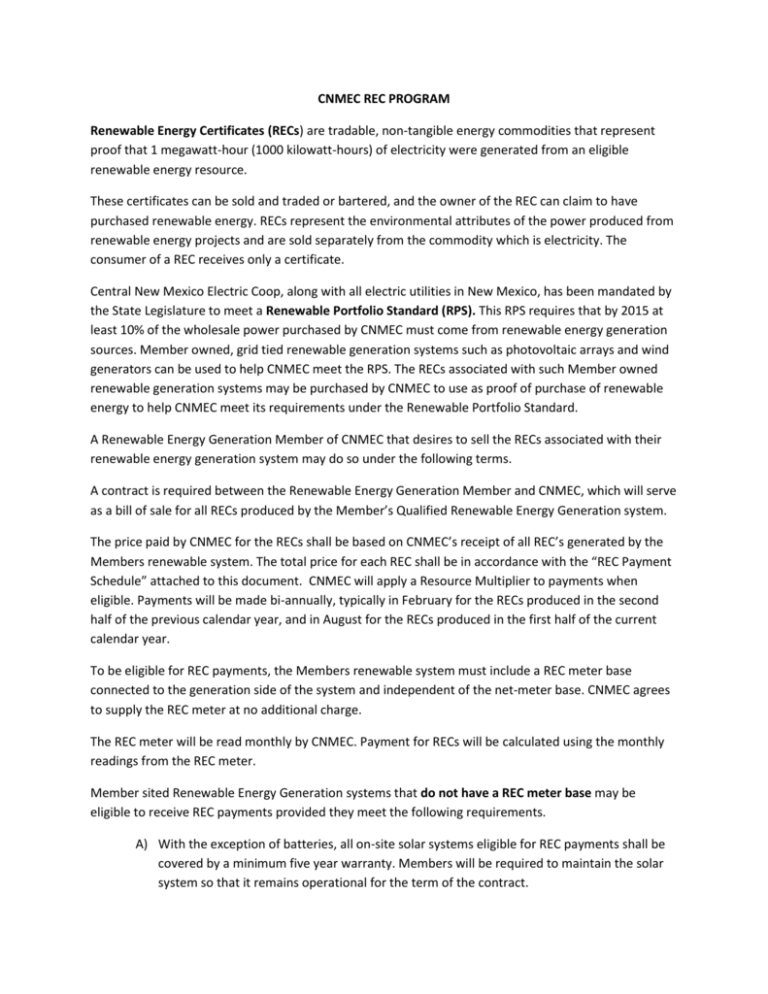
CNMEC REC PROGRAM Renewable Energy Certificates (RECs) are tradable, non-tangible energy commodities that represent proof that 1 megawatt-hour (1000 kilowatt-hours) of electricity were generated from an eligible renewable energy resource. These certificates can be sold and traded or bartered, and the owner of the REC can claim to have purchased renewable energy. RECs represent the environmental attributes of the power produced from renewable energy projects and are sold separately from the commodity which is electricity. The consumer of a REC receives only a certificate. Central New Mexico Electric Coop, along with all electric utilities in New Mexico, has been mandated by the State Legislature to meet a Renewable Portfolio Standard (RPS). This RPS requires that by 2015 at least 10% of the wholesale power purchased by CNMEC must come from renewable energy generation sources. Member owned, grid tied renewable generation systems such as photovoltaic arrays and wind generators can be used to help CNMEC meet the RPS. The RECs associated with such Member owned renewable generation systems may be purchased by CNMEC to use as proof of purchase of renewable energy to help CNMEC meet its requirements under the Renewable Portfolio Standard. A Renewable Energy Generation Member of CNMEC that desires to sell the RECs associated with their renewable energy generation system may do so under the following terms. A contract is required between the Renewable Energy Generation Member and CNMEC, which will serve as a bill of sale for all RECs produced by the Member’s Qualified Renewable Energy Generation system. The price paid by CNMEC for the RECs shall be based on CNMEC’s receipt of all REC’s generated by the Members renewable system. The total price for each REC shall be in accordance with the “REC Payment Schedule” attached to this document. CNMEC will apply a Resource Multiplier to payments when eligible. Payments will be made bi-annually, typically in February for the RECs produced in the second half of the previous calendar year, and in August for the RECs produced in the first half of the current calendar year. To be eligible for REC payments, the Members renewable system must include a REC meter base connected to the generation side of the system and independent of the net-meter base. CNMEC agrees to supply the REC meter at no additional charge. The REC meter will be read monthly by CNMEC. Payment for RECs will be calculated using the monthly readings from the REC meter. Member sited Renewable Energy Generation systems that do not have a REC meter base may be eligible to receive REC payments provided they meet the following requirements. A) With the exception of batteries, all on-site solar systems eligible for REC payments shall be covered by a minimum five year warranty. Members will be required to maintain the solar system so that it remains operational for the term of the contract. B) Solar systems must consist of equipment that is commercially available and factory new when installed on the original customer’s premises to be eligible for the REC payment. Rebuilt, used, refurbished, or homemade equipment is not eligible to receive the REC payment. C) The solar system installed must remain in place on the Member’s premises for the duration of its useful life. The Member’s equipment must have electrical connections in accordance with industry practice for permanently installed equipment, and it must be secured to a permanent surface (e.g., foundation, roof, etc.). Any indication of portability, including, but not limited to, wheels, carrying handles, dolly, trailer or platform, will render the system ineligible for participation and REC payments under the program. D) In lieu of a separate REC meter that records the output of the solar unit, the Member or its representative shall provide a calculation of the annual expected kilowatt-hour production from the Member’s solar system. The Member or its representative shall provide the following documentation to back up the Member’s calculation: 1) Tilt of the system in degrees (horizontal = 0 degrees); 2) Orientation of the system in degrees (south = 180 degrees); 3) A representation that the orientation of the system is free of trees, buildings and or other obstructions that might shade the system from the center point of the solar array through a horizontal angle plus or minus 60 degrees and through a vertical angle between 15 degrees and 90 degrees above the horizontal plane. 4) A calculation of the annual expected kWh of electricity produced by the system. For PV systems, the calculation of annual expected kWh of electricity will be based on the public domain solar calculator PVWatts Version1 (or equivalent upgrade). a) The weather station that is either nearest to or most similar in weather to the installation site; b) The system output rating which equals the module rating times the inverter efficiency times the number of modules; c) Array type: fixed tilt, single axis tracking, or 2 axis tracking; For variable tilt systems, the PVWatts calculations can be run multiple times corresponding to the number of times per year that the system tilt is expected to be changed using those months corresponding to the specific tilt angle used; d) Array tilt (degrees); and e) Array azimuth (degrees). 5) In the event PVWatts is no longer available, an equivalent tool shall be established. 6) For solar systems up to and including 10 kW, the REC payment may be adjusted, either up or down, based on the calculation of expected kWh of electric output derived from subsection 4) as compared with an optimally oriented fixed, i.e. non-tracking, system at the customer’s location, but only if the calculated system output differs from the optimally oriented system output by more than 10 percent. RECs will include ALL Environmental Attributes (defined below) that are created or produced by the installation. Environmental Attributes means any and all environmental characteristics that are attributable to renewable energy such as a) green tags, b) renewable energy credits (RECs), c) greenhouse gas or emissions reductions, d) credits, offset, allowances or benefits, e) any avoided emissions of pollutants to the air, soil, or water, including sulfur oxides (SO2), nitrogen oxides (NOX), Carbon dioxide (CO2), carbon monoxide (CO), methane (CH4), nitrous oxide, carbon, volatile organic compounds (VOC),mercury, and other emissions avoided, and f) any and all other green energy or other environmental benefits associated with the generation of renewable energyregardless of how any present or future law or regulation attributes or allocates such characteristics. Member owned solar systems commissioned prior to December 31, 2011 will qualify for a 3 times multiplier. The RECs associated with these solar systems will be purchased for the amounts listed on the schedule below times 3 ($14.97x3=$44.91 etc.) Solar systems commissioned after December 31, 2011 and wind generation systems will not qualify for any multiplier. REC Payment Schedule (Before applicable resource multipliers when eligible) YEAR 2012 2013 2014 2015 2016 2017 2018 2019 2020 2021 and beyond $ per REC (1000kWh) $14.97 $14.97 $14.97 $14.97 $8.50 $8.50 $8.50 $8.50 $8.50 $5.70
